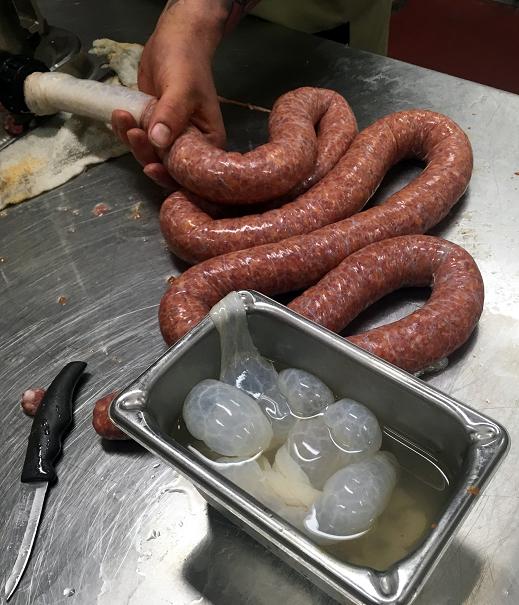 “My father told me once that there are three things in life that we must do: Work hard, be honest and make beautiful things” With these words John Van Der Lieck plunged his hands into a dark, shimmering paste of pork liver to the reverent, nodding ascent of a roomful of chefs.
“My father told me once that there are three things in life that we must do: Work hard, be honest and make beautiful things” With these words John Van Der Lieck plunged his hands into a dark, shimmering paste of pork liver to the reverent, nodding ascent of a roomful of chefs.
We were in the spacious commercial kitchen of North Island College’s Culinary Arts department for the NVICA Charcuterie Workshop; a two-day journey through the world of salting, curing, pressing and preserving meats. There were twenty or so of us foodservice pros gathered around John as he guided us from whole hog (literally!) to finished product and every critical step in between.
John was as close to a charcuterie master as one gets (although he’d be the first to shake his head and say “there’s no end to the learning”) and had driven up from the Comox Valley to show us the ropes. He was the founder of Oyama Sausage Co. in Vancouver and had spent the bulk of his career working on Granville Island producing world-class charcuterie for Van’s bustling foodservice industry and discerning foodies. Aside from being a skilled craftsman he was a joy to listen to and recounted proverbs, favourite recipes and anecdotes from his long career with the easy flow of a master storyteller.
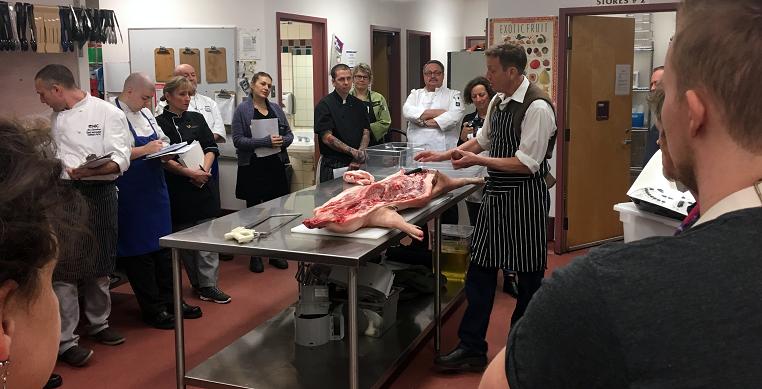 The hog was from Courteny’s own Lentelus Farm and came in two whole sides. When Chefs Xavier Bauby and Ronald St. Pierre trotted them out (sorry, couldn’t help that pun) an audile sigh went up from the assembled cooks indicating that I wasn’t the only one who hadn’t worked with such an impressive and daunting chunk of meat.
The hog was from Courteny’s own Lentelus Farm and came in two whole sides. When Chefs Xavier Bauby and Ronald St. Pierre trotted them out (sorry, couldn’t help that pun) an audile sigh went up from the assembled cooks indicating that I wasn’t the only one who hadn’t worked with such an impressive and daunting chunk of meat.
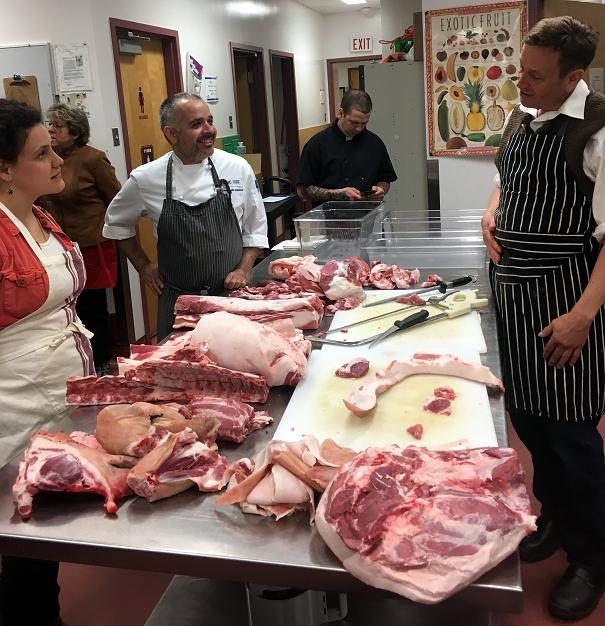 It certainly was no problem for John; armed only with a hacksaw and a thin boning knife he set about taking apart the beast and within an hour one whole side had been portioned into the kind of primals most of us would recognize. Each piece was described in detail and assigned to a particular pile depending on what type of fat or meat they contained and what sort of “beautiful things” could be made of them.
It certainly was no problem for John; armed only with a hacksaw and a thin boning knife he set about taking apart the beast and within an hour one whole side had been portioned into the kind of primals most of us would recognize. Each piece was described in detail and assigned to a particular pile depending on what type of fat or meat they contained and what sort of “beautiful things” could be made of them.
As John reiterated many times during the two days: “The key to good Charcuterie is determining what you want: Do you need meat to last? Do you need it cooked right away? What kind of flavour are you looking for? How much space do you have? Once you know, you can make whatever fits the criteria instead of working backwards and wasting meat.”
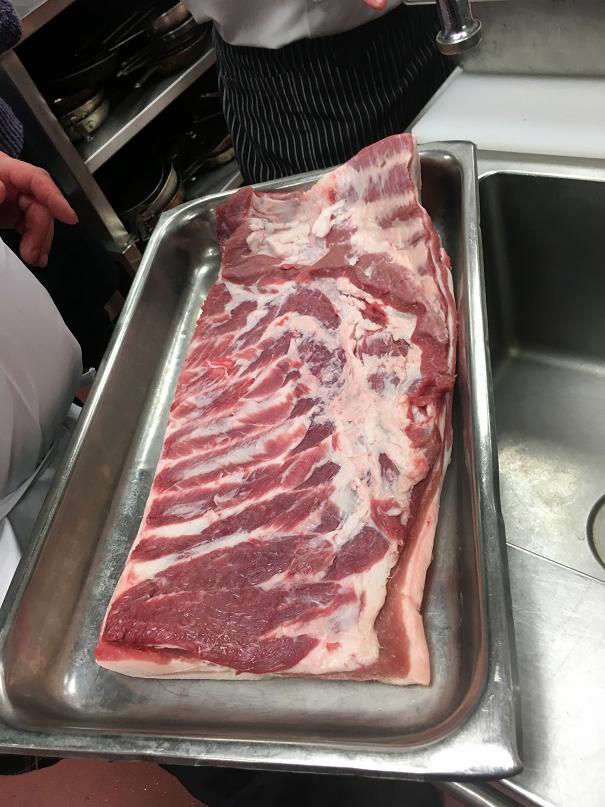 On day two everyone broke into groups and started cutting, rendering, scraping or in my case: fishing eyeballs out from the head. Soon piles of glistening pork fat were sorted into groups depending on the concentration of pure fat-to-meat. Anything that wasn’t going to be salted, brined or rendered was added to an enormous, rolling, gelatine-filled stock that would act as both a flavourful medium for the brine and as a binding agent for our terrines.
On day two everyone broke into groups and started cutting, rendering, scraping or in my case: fishing eyeballs out from the head. Soon piles of glistening pork fat were sorted into groups depending on the concentration of pure fat-to-meat. Anything that wasn’t going to be salted, brined or rendered was added to an enormous, rolling, gelatine-filled stock that would act as both a flavourful medium for the brine and as a binding agent for our terrines.
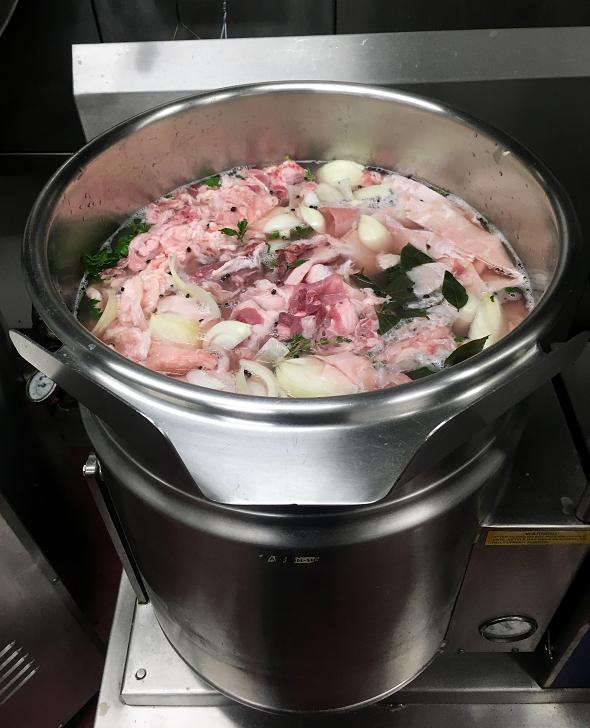 That’s right around when John brought out the offal. The liver was cleaned, heavily seasoned and ground to a mousse-like texture then wrapped in caul fat and baked. Tongue and pieces of meat plucked from the head were mixed with chopped pickles, salt, sugar and vinegar and encased in jellied stock then chilled to make Head Cheese.
That’s right around when John brought out the offal. The liver was cleaned, heavily seasoned and ground to a mousse-like texture then wrapped in caul fat and baked. Tongue and pieces of meat plucked from the head were mixed with chopped pickles, salt, sugar and vinegar and encased in jellied stock then chilled to make Head Cheese.
“Of course if you call it Head Cheese no one will buy it!” Laughed john, “So we’ll call it Tete de Cochon or what have you. That is why French cuisine is eternal! They have such wonderful names for things!”
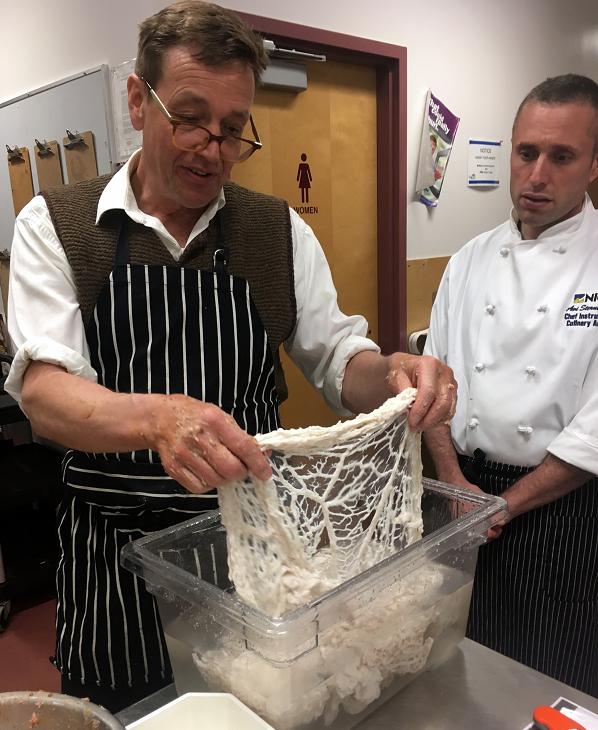 Once the brined pieces went into the smoker and the pates/terrines were squared away the whole crew surrounded John in the cold kitchen for a sausage making party. He fired up a big industrial grinder and a thermo mixer (imagine a big, temperature controlled vitamix) and fed through batches of pork, fat, salt and spices in varying quantities to produce five unique sausage fillings.
Once the brined pieces went into the smoker and the pates/terrines were squared away the whole crew surrounded John in the cold kitchen for a sausage making party. He fired up a big industrial grinder and a thermo mixer (imagine a big, temperature controlled vitamix) and fed through batches of pork, fat, salt and spices in varying quantities to produce five unique sausage fillings.
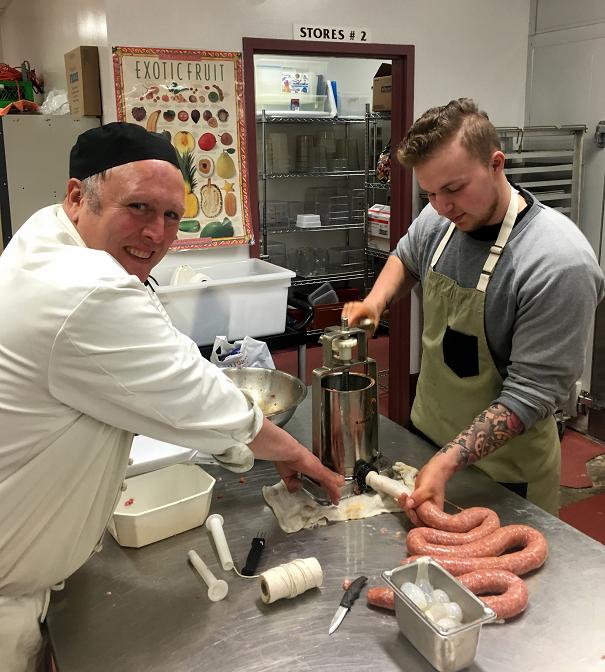 Chef-turned-farmer Brian McCormick from Clever Crow Farms out in Black Creek brought in a hand crank sausage stuffer and everyone took a turn feeding the hopper and guiding long tubes of ground meat into casings and then twirling them to create sausage links. This last step took a bit of finesse, but after a couple of tries under the guidance of the maestro even I got the hang of it.
Chef-turned-farmer Brian McCormick from Clever Crow Farms out in Black Creek brought in a hand crank sausage stuffer and everyone took a turn feeding the hopper and guiding long tubes of ground meat into casings and then twirling them to create sausage links. This last step took a bit of finesse, but after a couple of tries under the guidance of the maestro even I got the hang of it.
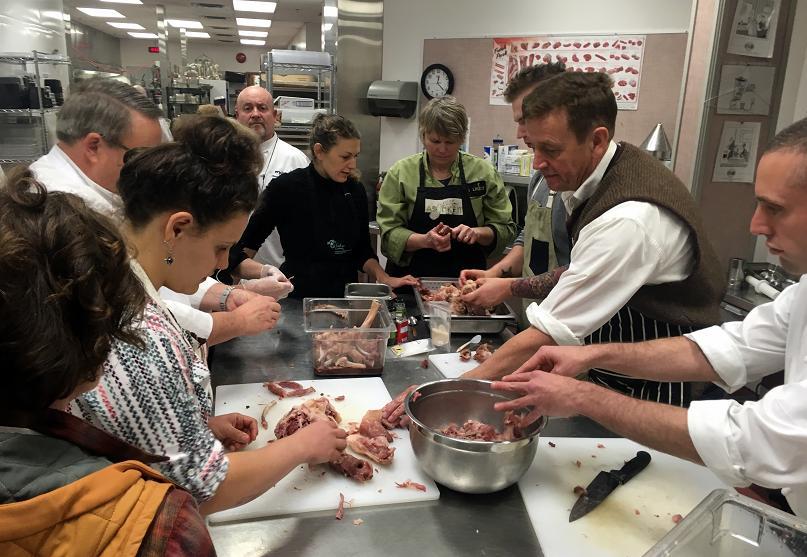 This was the heart of the whole two day affair. Everyone got their hands into a bowl of ground pork and spices or twirled a crank while someone else fed the stuffer. Instead of lone wolf chefs from desperate worlds babysitting pots at various ends of the kitchen everyone was together in this beautiful messy business. Once all the casings were filled and pricked it was time to eat!
This was the heart of the whole two day affair. Everyone got their hands into a bowl of ground pork and spices or twirled a crank while someone else fed the stuffer. Instead of lone wolf chefs from desperate worlds babysitting pots at various ends of the kitchen everyone was together in this beautiful messy business. Once all the casings were filled and pricked it was time to eat!
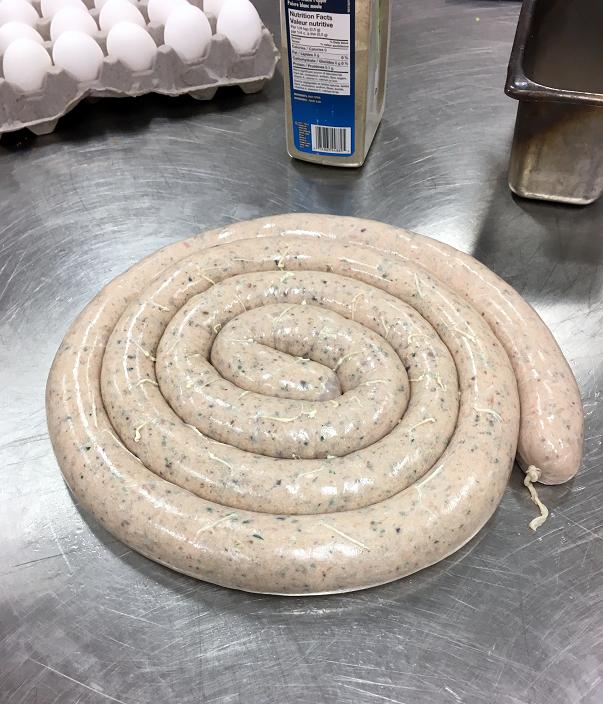 Over on NIC’s vast line a couple pans were fired up and the freshly made sausages started to sizzle and pop, terrines were un-moulded and pates were carefully sliced and arranged onto platters. We all sat down in the NIC Dining Room and tucked into the beautiful things we had made from such inelegant hunks of pig… Crostinis and napkins were offered, but in my enthusiasm I mostly used my hands.
Over on NIC’s vast line a couple pans were fired up and the freshly made sausages started to sizzle and pop, terrines were un-moulded and pates were carefully sliced and arranged onto platters. We all sat down in the NIC Dining Room and tucked into the beautiful things we had made from such inelegant hunks of pig… Crostinis and napkins were offered, but in my enthusiasm I mostly used my hands.
Both terrines were spectacular! The liver was subdued and perfectly accentuated with spices so that there was no organy aftertaste. The peppercorns were a perfect fit and the caul fat (which I was able to take home a wee bit of) provided both a structure for the terrine, a crisp lid to eat and added fat to the whole affair. The head cheese was equally great and had a variety of really exciting textures, including my personal favourite; the tongue!
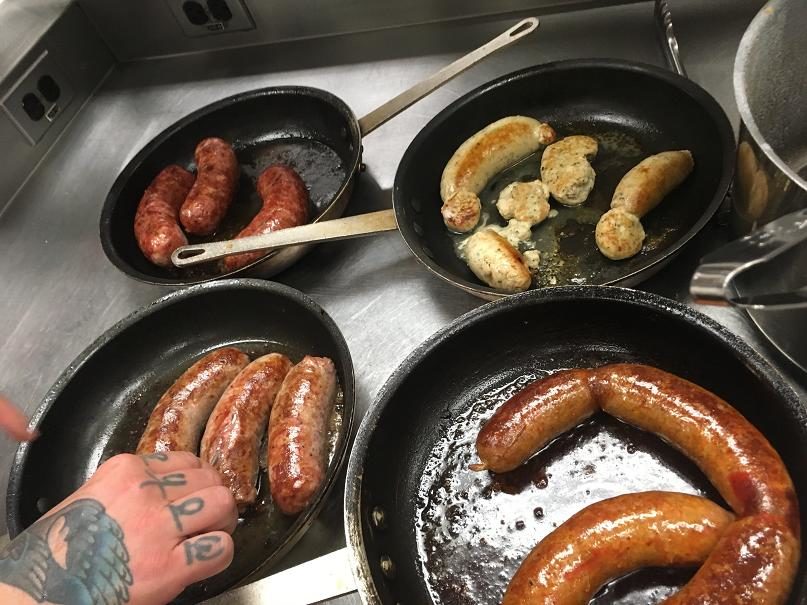 Speaking of favourites: I’m a sucker for a “farmer-style” sausage so the Toulouse-style and Chef Brian’s “Special” sausages were admittedly my favourites of the whole workshop! Both were rough and herbal with just a hint of lemon, rosemary and just enough of that distinctive offal twang to make things interesting.
Speaking of favourites: I’m a sucker for a “farmer-style” sausage so the Toulouse-style and Chef Brian’s “Special” sausages were admittedly my favourites of the whole workshop! Both were rough and herbal with just a hint of lemon, rosemary and just enough of that distinctive offal twang to make things interesting.
Both the Paprika-spiked Chorizo and Morteau sausages were exceptional and more aggressively spiced than I ever imaged while mixing up the filling. The smoke added another layer of BBQ cookout/Lousisana hotsauce/hot summer tarmac flavour to them both and the char from the frying pan added a beautiful crust.
Finally, the Boudin Blanc was a combination of bright white pork fat, a bit of chicken, bread soaked in cream, lemon and herbs. The colour was (as you’d expect) pale as a ghost and full of subtle, bright flavours and the texture was mousse-like in its smoothness. It was a perfect foil for all of the other more assertive, fatty sausages and gave our meat board a dash of class.
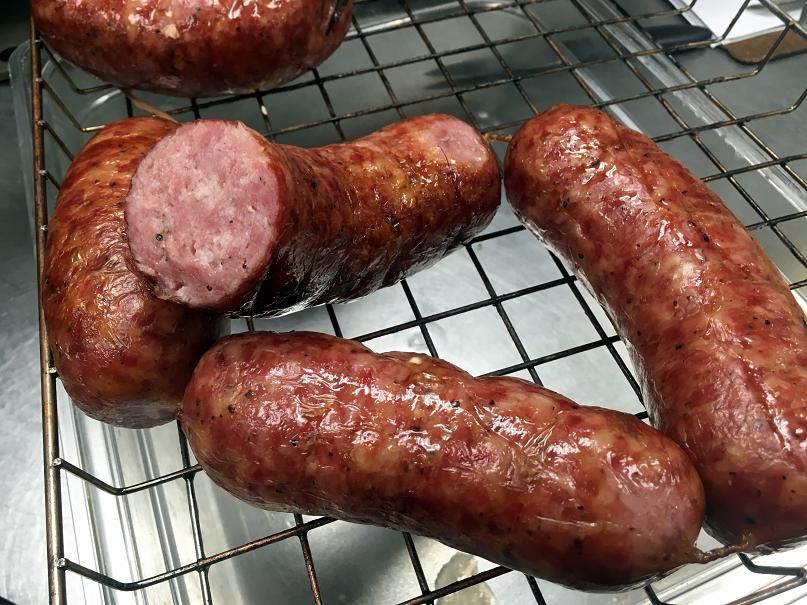 And that was about it. After we’d gorged on our handiwork and fed the dishes through the washer we got a last chance to ask john questions and then mill around exchanging emails with all the great new friends we’d made. Everyone couldn’t wait to bust out the grinder at their work and start cranking out house-made charcuterie!
And that was about it. After we’d gorged on our handiwork and fed the dishes through the washer we got a last chance to ask john questions and then mill around exchanging emails with all the great new friends we’d made. Everyone couldn’t wait to bust out the grinder at their work and start cranking out house-made charcuterie!
Big thanks to:
Lesley Stav from NVICA for squeezing Matt and I into that already crammed kitchen.
Chef’s Xavier, Ronald and Brian for keeping the train running on time and sometimes even on the tracks.
John, for all the knowledge, hands-on pointers and stories.
Britta, we owe you some sausage.
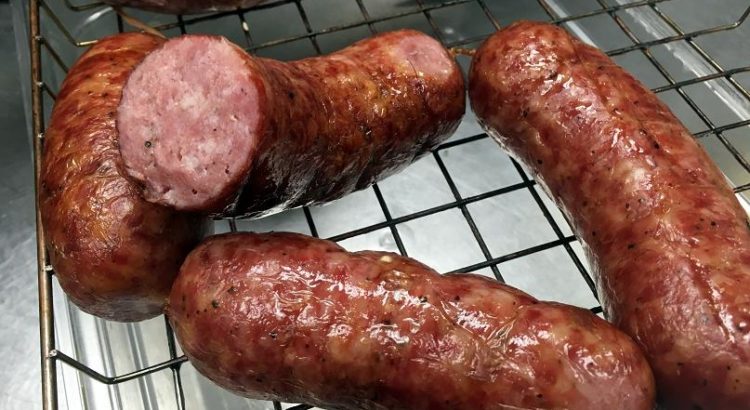
I saw our pig Shawn. Am so glad you have these opportunities to learn and grow. Can’t wait to meet some of your colleagues.
For those not in the know, she means This Pig!